
The Biltmore Los Angeles is a historic hotel opened in 1923 and located opposite Pershing Square in Downtown Los Angeles, California. The hotel has 70,000 square feet (6,500 m2) of meeting and banquet space. Built with 1500 guestrooms, it now has 683.

The Palace Hotel is a landmark historic hotel in San Francisco, California, located at the southwest corner of Market and New Montgomery streets. The hotel is also referred to as the New Palace Hotel to distinguish it from the original 1875 Palace Hotel, which had been demolished after being gutted by the fire caused by the 1906 San Francisco earthquake.

Howard Greenley (1874–1963) was an architect who worked during the late 19th and 20th centuries and known mainly for his work in New York City, Long Island, and Newport, Rhode Island. Greenley was a prominent figure in the architectural world in his time, He graduated from Trinity College in Hartford, Connecticut in 1894, having trained initially in the office of Carrere and Hastings and then at the École des Beaux-Arts in Paris. Greenley served as the president of the Architectural League of New York for a quarter of a century, and was one of the featured architects in the book Long Island Country Houses and Their Architects 1860 to 1940 by Robert Mackay and Brendan Gill.
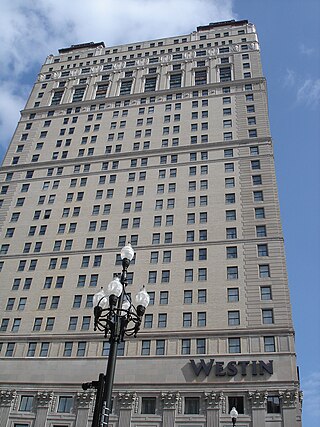
The Westin Book Cadillac Detroit is an historic skyscraper hotel in downtown Detroit, Michigan, within the Washington Boulevard Historic District. Designed in the Neo-Renaissance style, and opened as the Book-Cadillac Hotel in 1924, the 349 ft (106 m), 31-story, 453-room hotel includes 65 exclusive luxury condominiums and penthouses on the top eight floors. It reopened in October 2008, managed by Westin Hotels, after a $200-million restoration.
The Sioux City Art Center began as a Works Progress Administration (WPA) project in 1937 when the Art Center Association of Sioux City, the Sioux City Junior League, as well as other community supporters, received a grant of $3,000 to create the first art center. After the Federal Assistance Program ended in 1940, the Sioux City City Council voted to fund the Art Center and established the Board of Trustees, the City's fiscal governing board for the Art Center in 1941. It is located in Sioux City, Iowa.

InterContinental Chicago Magnificent Mile is a hotel in Chicago, United States. The hotel currently occupies two multi-story buildings. The historic tower, or "South Tower," is a 471-foot (144 m), 42-story building which was completed in 1929 originally as the home of the Medinah Athletic Club. The new tower, or "North Tower" is a 295-foot (90 m), 26-story addition, completed in 1961.
Eugene C. Eppley also known as Gene, was a hotel magnate in Omaha, Nebraska. Eppley is credited with single-handedly building one of the most successful hotel empires, by the 1950s the largest privately owned hotel chain in the United States.
The Eppley Hotel Company was located in Omaha, Nebraska. At the time of its acquisition by the Sheraton Corporation in 1956, it had 22 properties, and it was the largest privately held hotel business in the United States.
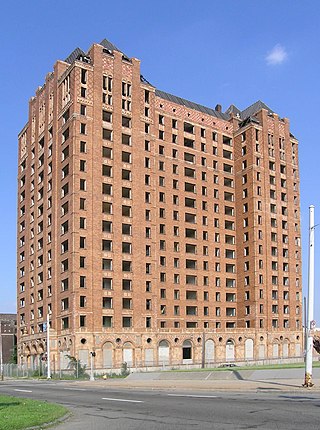
The Lee Plaza is a vacant 16-story high-rise apartment building located at 2240 West Grand Boulevard, about one mile west of New Center along West Grand Boulevard, an area in Detroit, Michigan. It is a registered historic site by the state of Michigan and was added to the United States National Register of Historic Places on November 5, 1981. Designed by Charles Noble and constructed in 1929, it rises to 16 floors and is an excellent example of Art Deco architecture of the 1920s.
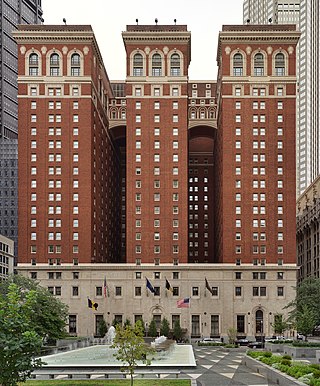
The Omni William Penn Hotel is a 23 floor hotel located at 530 William Penn Place on Mellon Square in downtown Pittsburgh, Pennsylvania. A variety of luminaries have stayed at the hotel, including John F. Kennedy. The hotel staff innovated Lawrence Welk's now famous bubble machine, and it was the site of Bob Hope's marriage proposal in 1934. The hotel has won numerous awards including being named to the "Best of Weddings 2009" list by The Knot and receiving the Editor's Choice Award in the Business Hotels category on Suite101.com.

The Hotel Tallcorn is located in Marshalltown, Iowa. Today it is called the Tallcorn Towers Apartments. Built in 1928 by the Eppley Hotel Company, local citizens contributed $120,000 to ensure the successful completion of this seven-story hotel. It was completed in connection to the seventy-fifth anniversary of Marshalltown. The hotel's sale in 1956 from the Eppley chain to the Sheraton Corporation was part of the second largest hotel sale in United States history. The Tallcorn was listed as a contributing property in the Marshalltown Downtown Historic District on the National Register of Historic Places in 2002.

The Atlanta Biltmore Hotel and Biltmore Apartments is a historic building located in Atlanta, Georgia. The complex, originally consisting of a hotel and apartments, was developed by William Candler, son of Coca-Cola executive Asa Candler, with Holland Ball Judkins and John McEntee Bowman. The original hotel building was converted to an office building in 1999. The building is currently owned by the Georgia Institute of Technology and is adjacent to Technology Square.
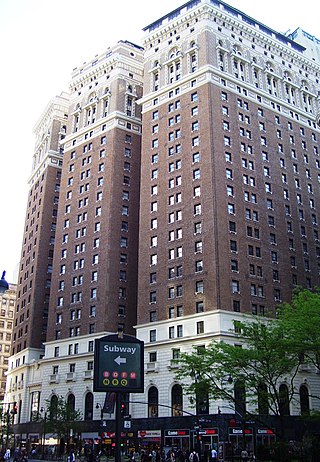
Herald Towers, formerly the Hotel McAlpin, is a residential condominium building on Herald Square, along Broadway between 33rd and 34th Streets, in the Midtown Manhattan neighborhood of New York City. Constructed from 1910 to 1912 by the Greeley Square Hotel Company, it operated as a short-term hotel until 1976. The building was designed by Frank Mills Andrews in the Italian Renaissance style and was the largest hotel in the world at the time of its completion, with 1,500 guestrooms. The hotel was expanded in 1917, when Warren and Wetmore designed an annex with 200 rooms.

The Marriott Syracuse Downtown is a historic hotel located at 100 E. Onondaga St., Syracuse, New York. It was built in 1924 as the Hotel Syracuse and was completely restored in 2016, when it joined the Marriott chain.

The Statler Hotel & Residences is a hotel of mid-twentieth century design located at 1914 Commerce Street in downtown Dallas, Texas (USA). It is located on the edge of the Farmers Market District and adjacent to Main Street Garden Park. The hotel opened in 1956 as The Statler Hilton and was praised as the first modern American hotel and was designed by William B. Tabler. Later renamed the Dallas Grand Hotel, it closed in 2001, then was restored and reopened in 2017. It is currently a member of Historic Hotels of America, the official program of the National Trust for Historic Preservation.

The Sheraton New York Times Square Hotel is a 501 ft (153 m), 51-story hotel located near Times Square in Midtown Manhattan, New York City. It faces 7th Avenue, 52nd Street, and 53rd Street. It is one of the world's 100 tallest hotels, and one of the tallest hotels in New York City.

The Warrior Hotel is a historic hotel opened in 1930 and restored in 2020, located in downtown Sioux City, Iowa, United States.

The Hotel Cleveland is a historic hotel on Public Square in Cleveland, Ohio, opened in 1918. It is today part of the Tower City Center mixed-use complex.

The Chieftain Hotel is a historic former hotel building at 38 Pearl Street in Council Bluffs, Iowa, United States. It opened in 1927, the result of a partnership between the Eppley Hotel Company and local patrons, and was built on the site of the Grand Hotel, which had opened in 1891 and was destroyed by a fire in 1925. The hotel was eight stories tall, and featured 153 guest rooms.
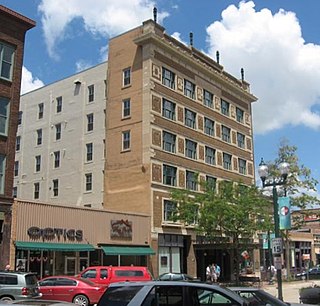
The Carpenter Building, historically the Carpenter Hotel or Hotel Carpenter and known colloquially as The Carpenter, is a historic building at 221 South Phillips Avenue in downtown Sioux Falls, South Dakota. Originally serving as a hotel from 1912 to 1966, it is now used for retail and apartment space. It was listed on the National Register of Historic Places in 1986.




















